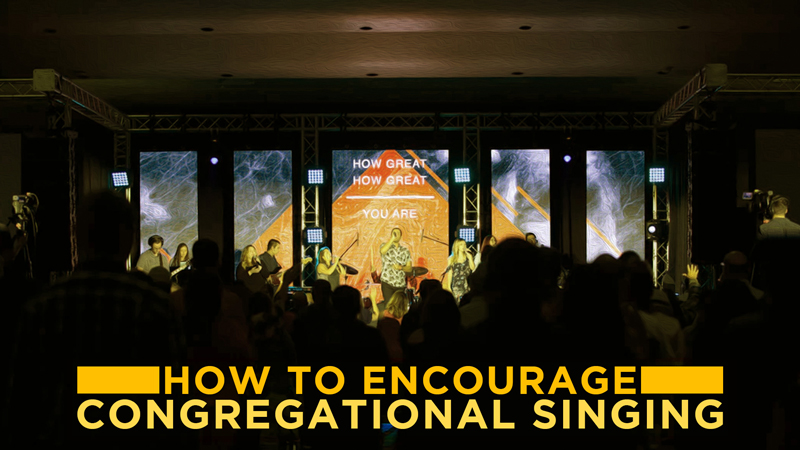In the first article of this two-part series on church worship, I laid out some thoughts on how to get the congregation involved; to help them to be heard; to encourage them to sing. We provided some tangible, practical applications for the worship leaders. I left out the sound operator in the last article because I wanted everyone to know that we will only hear the congregation if all of us: worship leader, musicians, media and sound techs are working towards that goal. We each have a vital part to play in this.
Let’s quickly recap what was covered in the first article Church Worship: How To Encourage Congregational Singing – Part 1
- Lead with songs we know
- Lead songs that are appropriate for congregational singing
- Sing songs in keys that we can sing (C-to Shining C)
- Invite the congregation to sing (step away from your microphone and encourage them to sing)
- Incorporate Choirs; They inspire us to sing!
- Arrangements for the band that provide space, dynamics, and the right levels.
- This is not a concert; it’s a worship service.
In this post, I will focus on what it is that the sound operator can do to achieve the goal. We’ll also look at the sound system and what improvements could be made to help the congregation to hear ourselves better.
Church Worship: How To Encourage Congregational Singing – Part 2
Let’s begin
Communication with the worship leader and the band is vitally important. Communications are better when we know with whom we are communicating. Stronger relationships encourage trust between the parties. You need to be able to say things to each other without fear of offending. If the guitar player is too loud, I hope you have a friendly relationship with him before you tell him to turn it down. Remember our goal. If the band is too loud on the stage, the main mix in the sanctuary will have to be louder.
You need to work this out ahead of time. Some churches use SPL meters (sound pressure level; dB) to establish thresholds for loudness levels in their churches. Many times they are not based on reality. They only show an average or peak level. They don’t show how musical, bright, dark, distorted, noisy, unbalanced, nuanced or how inarticulate a mix may be.

Levels right?
Are your levels right? This is first.
The balance of Voices and instruments, second.
EQ, third.
Reverb, delay, effects… last.
“A new scientific study from Dr. David Gauger, a music professor at Moody Bible Institute, found that such sound levels discourage congregational participation. “When you get above 90 decibels, it drops off dramatically,” Gauger said. “They do not feel they can worship. They cannot hear their own voice. They do not feel supported.”
Meters have their place, but your ears are your best tool. 90 dB may be the right threshold or it may not be. I’m not certain I agree with that threshold, as a rule in all places at all times. Listening is the best way to determine loudness levels and if the mix is right or not.
“If the volume is too high, it can hurt worship. People will be distracted and instead of focusing on the words and worshipping, they will think about how loud it is and that their ears are hurting, or leave. I know it is impossible to please everyone, but as church sound technicians we do not want to chase people away or cause hearing damage because our services are too loud.”

On the other hand, levels may be too soft. As a sound operator, you need to be aware of your surroundings. Use your eyes and your ears to determine if the levels are too much or not enough. The congregation will not engage if it’s too loud. It has now become a concert. If it’s too soft they will not engage because they don’t want to be heard over the band.

“Gauger’s study determined that too-soft music also deterred congregational singing. The lack of sufficient volume was having a negative effect on the worship service. When the volume is too low it can stifle their participation.”
Let’s look at the sanctuary system for a second. The goal of any sound system should be to provide articulate, intelligible coverage of the room in every seat at the right level. Some churches don’t have enough in the way of loudspeakers in the room to do this. You may have one pair of speakers in the front of the hall that you are trying to fill the room with. The people in the back are straining to hear and the folks in front are getting crushed with too much sound.
In longer rooms like this, we would typically set up a delay speaker(s) so that the people in the back can hear at a level that’s comfortable while still providing a normal level for the front sections. In some cases, we need to provide coverage in other areas, like the sides, under the balcony, foyer, etc.
When we can cover the room equally we will have a greater potential to provide the right level for the whole church. Don’t skimp here.

So that about sums it up.
I am including links to other articles that reinforce these ideas.
- 3 Keys to Teaching New Songs by Chris Vacher
- Volume Levels and hearing Safety at Covenant Life Church
- A Critical Look at Loudness
- 10 Things I Did Not Do that Improved My Congregation’s Singing Scott Connell
- How Loud Should our Church Music Be Jordan Richmond
- How Loud the Worship Team Worship Matters
- Nine Reasons People Aren’t Singing in Worship
- The Sound that Kills Worship

